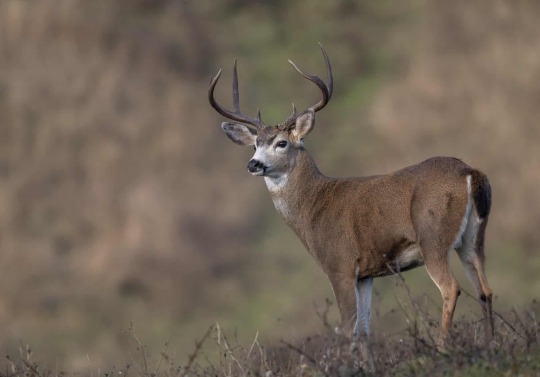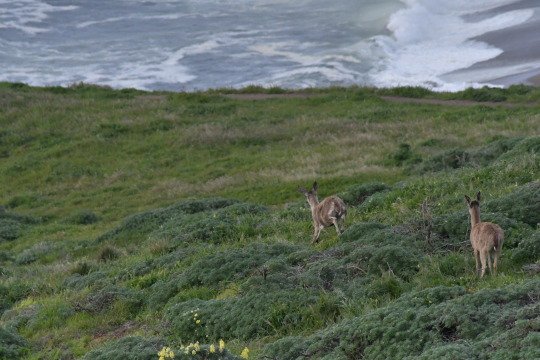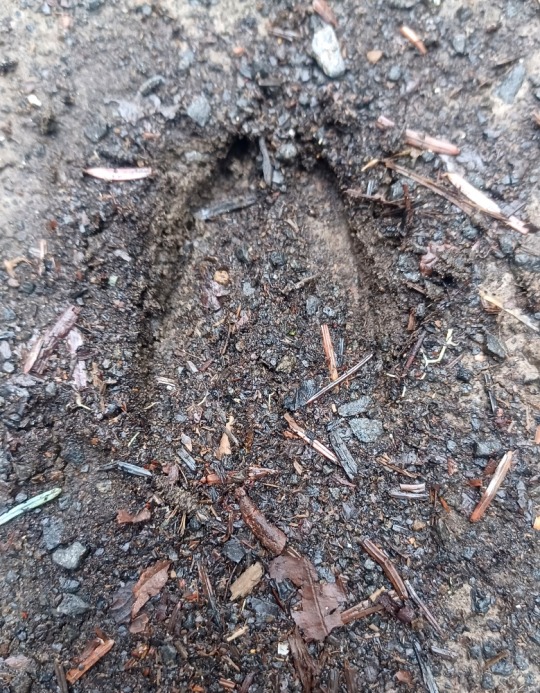#black-tailed deer
Explore tagged Tumblr posts
Text
Columbian black-tailed deer (Odocoileus hemionus columbianus)

White Boy spotted in Washington

Seeing white deer isn’t all that rare around here but this lil baby was just SO CUTE with his giant brown nose I had to draw em
#nice art op#columbian black-tailed deer#black-tailed deer#odocoileus hemionus columbianus#image#deer
1K notes
·
View notes
Text

It’s Tell a Friend Friday! Please enjoy this picture of a Columbian black-tailed buck (Odocoileus hemionus columbianus) just outside my kitchen window.
Then tell someone you know about my work–you can reblog this post, or send it to someone you think may be interested in my natural history writing, classes, and tours, as well as my upcoming book, The Everyday Naturalist: How to Identify Animals, Plants, and Fungi Wherever You Go. Here’s where I can be found online:
Website - http://www.rebeccalexa.com
Rebecca Lexa, Naturalist Facebook Page – https://www.facebook.com/rebeccalexanaturalist
Tumblr Profile – http://rebeccathenaturalist.tumblr.com
BlueSky Profile - https://bsky.app/profile/rebeccanaturalist.bsky.social
Twitter Profile – http://www.twitter.com/rebecca_lexa
Instagram Profile – https://www.instagram.com/rebeccathenaturalist/
YouTube Profile - https://www.youtube.com/@RebeccaLexaNaturalist
LinkedIn Profile – http://www.linkedin.com/in/rebeccalexanaturalist
iNaturalist Profile – https://www.inaturalist.org/people/rebeccalexa
Finally, if you like what I’m doing here, you can give me a tip at http://ko-fi.com/rebeccathenaturalist
#deer#black-tailed deer#mule deer#cervine#buck#mammals#animals#wildlife#wild animals#nature#nature photography#scicomm#science#biology#zoology#PNW#Pacific Northwest#Cervidae#cervids#Tell a Friend Friday
29 notes
·
View notes
Photo

A black-tailed deer in rut keeps his eye on a nearby doe on a hillside near Elkton, rural Oregon
Photograph: Robin Loznak/Zuma Press Wire/Rex/Shutterstock
#robin loznak#photographer#zuma press wire#rex#shutterstock#black-tailed deer#deer#animal#mammal#wildlife#doe#elkton#oregon#nature
126 notes
·
View notes
Note
Hello! I've noticed your posts of Columbian black-tailed deer are labelled Odocoileus columbianus columbianus, and sitka black-tailed deer are Odocoileus columbianus sitkensis. I've seen literature which considers both to be a subspecies of mule deer (Odocoileus hemionus)—naming them Odocoileus hemionus columbianus and Odocoileus hemionus sitkensis respectively—and so have wondered if you might share your reasoning for your taxonomic schema. Thank you, and thank you for the wonderful posts!
Hi! Glad you're enjoying the ungulates :)
Regarding the status of the black-tailed deer, the traditional position is that the two subspecies belong to the mule deer, O. hemionus, as each other's closest relatives. Following the genetic trees established by this paper (which, I believe, has also contributed to work like the resurrection of Pudella and description of Pudella carlae earlier this year), however, the two black-tailed deer are recovered as sister to one another, but not to O. hemionus.
The authors note that it is possible that this may be because of incomplete lineage sorting in the fairly-young North American Odocoileus radiation, or because of the absence of robust nuclear DNA data from the genus. While the authors refrain from elevating O. columbianus to species status pending further results, the taxonomy used on this blog is not tied to any one particular source, is not meant to be authoritative, and follows my own taxonomic inclinations. I tend to take a "splitter" position, and as black-tailed deer have long been recognized as distinctive relative to (other) mule deer, I tentatively favor recognition of a separate Pacific coastal species of dark-tailed Odocoileus. I have recently acquired some additional recent papers on mule deer taxonomy and genetic structure, and as I make my way through these -- and further research is done on the rather confused relationships of New World deer -- I will reevaluate my opinions should the scale tip harder toward the position that the black-tailed deer are within O. hemionus.
Paper linked above is:
Gutiérrez, EE, KM Helgen, MM McDonough, F Bauer, MTR Hawkins, LA Escobedo-Morales, BD Patterson, and JE Maldonado. 2017. A gene-tree test of the traditional taxonomy of American deer: the importance of voucher specimens, geographic data, and dense sampling. ZooKeys 697:87-131.
#posting about taxonomy#asks#Odocoileus hemionus#mule deer#Odocoileus columbianus#black-tailed deer#Cervidae#deer
12 notes
·
View notes
Photo







followed a doe over a hillside and discovered another doe and three fawns. all of them were charmingly scruffy after the recent rain. two of the fawns had an intriguing light coat; uncertain if leucism or just a result of being wet.
#deer#i thiiiink these are#black-tailed deer#as they are definitely not fallow deer which is the other option for the area#mule deer
60 notes
·
View notes
Text
Columbian black-tailed deer (Odocoileus hemionus columbianus)
Love him... love mr. cool...
134K notes
·
View notes
Text
A velvet-antlered black-tailed deer stag.



Photos by Xer S. Rowan, Creative Commons Attribution license, linktr.ee/DoingItForTheExposure
I take photos for the love of photography and share them under a free-to-use-as-long-as-I-am-properly-credited license.
#deer#black-tailed deer#deer photography#deerblr#creative commons photography#original photography on tumblr#backyard photography#wildlife photography#urban wildlife#free stock images#free photos#creative commons#photography
0 notes
Text

It’s Tell a Friend Friday!
Please enjoy this photo I took of the hoofprint of a Columbian black-tailed deer (Odocoileus hemionus columbianus).
Then tell someone you know about my work–you can reblog this post, or send it to someone you think may be interested in my natural history writing, classes, and tours, as well as my upcoming book, The Everyday Naturalist: How to Identify Animals, Plants, and Fungi Wherever You Go. Here’s where I can be found online:
Website - http://www.rebeccalexa.com
Rebecca Lexa, Naturalist Facebook Page – https://www.facebook.com/rebeccalexanaturalist
Tumblr Profile – http://rebeccathenaturalist.tumblr.com
BlueSky Profile - https://bsky.app/profile/rebeccanaturalist.bsky.social
Twitter Profile – http://www.twitter.com/rebecca_lexa
Instagram Profile – https://www.instagram.com/rebeccathenaturalist/
LinkedIn Profile – http://www.linkedin.com/in/rebeccalexanaturalist
iNaturalist Profile – https://www.inaturalist.org/people/rebeccalexa
Finally, if you like what I’m doing here, you can give me a tip at http://ko-fi.com/rebeccathenaturalist
#track#animal tracks#tracking#nature#wildlife#deer#black-tailed deer#mule deer#mammals#scicomm#science communication#ecology#environment#conservation#science#animals#science education
12 notes
·
View notes
Text


Columbian Black-Tailed Deer | MRNP
#artists on tumblr#original photographers#original photography#hiking#pacific northwest#nature#washington#pnw#nikon#orofeaiel#animals#wildlife#deer#columbian black tailed#four legged friends#locals#fog#forest#landscape#moody
1K notes
·
View notes
Text
Columbian black-tailed deer (Odocoileus hemionus columbianus)



a hard rain’s a‐gonna fall.
2K notes
·
View notes
Link
Columbian black-tailed deer range from southern British Columbia to Southern California, and as far east as the Cascade Range and southern Sierra Nevada. They are native to this archipelago. They are also wildly out of balance. By the late 1800s, foreign settlers had exterminated the islands’ cougars and wolves, the deer’s primary predators, and alienated Indigenous people from their traditional deer hunting grounds. Over the past century, wildlife managers here and across the continent encouraged the proliferation of all deer species—popular game animals. More recently, changes in regulations and cultural attitudes have resulted in a dramatic drop in hunting. Deer have never had it so easy. Martin estimates that their population on the islands is now 10 times what it was before colonists arrived.
Here and there, oceanspray shoots up like topiary umbrellas. Indigenous people used these flowering shrubs, also known as ironwood, for making tools and utensils. Well past two meters tall, these specimens are old-timers, Martin explains, up to 100 years in age, that have been relentlessly clipped and shaped by deer who swim between islands. Few, if any, new oceanspray plants survive because deer eat them before they can establish. It’s the same for other bushes and flowering plants. Seedling and sapling trees often meet a similar fate. Native deer prefer to browse native fare, especially succulent flowering plants, giving unpalatable invasive plant species an edge. Gone too are the native, perennial, tussock-forming grasses that some birds favor for nesting. What the deer leave behind is an impoverished understory dotted with moss and thorny Himalayan blackberry. And the evidence of deer overbrowsing reaches well beyond the trees.
Martin leads me to a meadow near the beach where the sun illuminates a grassy field of vibrant green. While I take in the inviting scene, she conjures a vanished world of purples and pinks, the trill and hum of pollinating birds and bees—the way this meadow used to be. Martin grew up just 22 kilometers north of here, on Saltspring Island, in the 1970s. “There were places you could be knee-deep in wildflowers,” she recalls. Now, with the proliferation of deer, development, and other stressors, “those places are long gone.” They’ve been replaced by a carpet of invasives, including European orchard grass. It’s a process repeated throughout the archipelago, she says, and wherever overabundant deer are found.
#history#colonialism#climate change#ecology#environmentalism#animals#zoology#wildlife conservation#canada#usa#gulf islands#d'arcy island#salt spring island#deer#black-tailed deer
1 note
·
View note
Text


104 notes
·
View notes
Text

Columbian black-tailed deer Odocoileus columbianus columbianus
Observed by eckhartdpe, CC BY
#Odocoileus columbianus columbianus#Columbian black-tailed deer#Cervidae#deer#North America#United States#California
96 notes
·
View notes
Text
Columbian black-tailed deer (Odocoileus hemionus columbianus)


just watched this guy fumble two does in a row
10K notes
·
View notes
Text

a little fawn, just carved last night while I couldn’t sleep
#accidentally spattered this trivet with black but I just went with it#reserved#pottery#ceramics#ceramic#sgraffito#ceramic art#carving#timelapse#ceramic trivet#fawn art#fawn#deer#baby deer#white tailed deer#time lapse#timelapse video
210 notes
·
View notes
Text

I wish I wasn’t insane. I wish I could be understood.
#2014 tumblr#black swan#lana del rey#lizzy grant#priscilla movie#2014 aesthetic#girl interrupted#lana del ray aka lizzy grant#girlblogger#this is a girlblog#pearl movie#mia goth#female rage#female hysteria#female manipulator#white tailed deer
23 notes
·
View notes